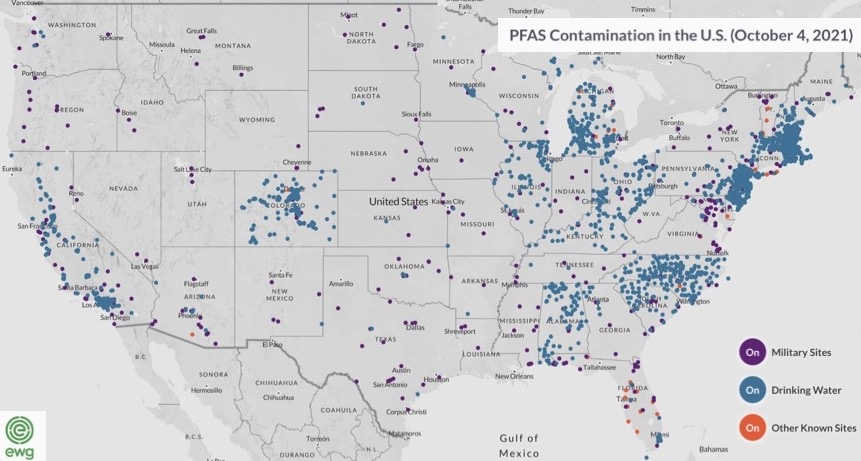INSTITUTE INDEX: The slow move toward 'forever chemical' regulation

Environmental Working Group map showing documented PFAS pollution nationwide as of this month; click here for an interactive version.
Date on which Environmental Protection Agency Administrator Michael Regan unveiled a "comprehensive strategic roadmap" to confront widespread pollution from per- and polyfluoroalkyl substances, the health-damaging chemicals known as "PFAS" or "forever chemicals" because of their persistence in the environment: 10/18/2021
Year by which the EPA aims to set a drinking water standard for two common PFAS, PFOA and PFOS: 2023
Estimated number of U.S. residents now drinking water contaminated with PFAS, which are used to make nonstick cookware, stain- and water-resistant textiles, firefighting foam, and personal care products, and which have been linked to cancer, decreased infant birth weights, increased cholesterol levels, and a greater risk of contracting infectious diseases including COVID-19: 200 million
Number of U.S. military installations where PFAS contamination has been confirmed: nearly 400
Estimated number of industrial facilities in the U.S. that are discharging PFAS into the air and water: 30,000
Percent of the U.S. population that has detectable levels of PFAS in their bodies: more than 95
Year in which EPA Administrator Regan — then serving as the head of North Carolina's Department of Environmental Quality — ordered DuPont spinoff Chemours to address extensive PFAS pollution in the Cape Fear River basin from its plant near Fayetteville: 2019
Number of people who rely on the Cape Fear River basin for drinking water: nearly 1 million
Amount North Carolina fined Chemours earlier this month for exceeding PFAS emission limits, the second time this year the state fined the company for its pollution: $300,000
Miles from Chemours' Fayetteville facility that its PFAS pollution has been found: 90
Year since the EPA has known about health risks posed by PFAS: 1998
Year in which Robert Bilott, an attorney who represented about 80,000 people whose drinking water was contaminated with PFAS from a DuPont plant in West Virginia, first wrote to the EPA asking it to take action to protect the public: 2001
If the process were to begin immediately, minimum number of years it would take the EPA to restrict or ban the use of a category of PFAS: 7
Year in which the FDA approved the use of food containers with PFAS in them: 1983
Evidence the FDA has reviewed the safety of these containers since then or measured how much PFAS they're putting into food: 0
In a study of fast-food wrappers collected in 2014 and 2015, portion that had detectable levels of PFAS: almost 1/2
Number of states that have adopted policies restricting PFAS in food packaging: 19
Number of those states that are in the South: 1*
* Virginia.
(Click on figure to go to source.)
Tags
Sue Sturgis
Sue is the former editorial director of Facing South and the Institute for Southern Studies.
